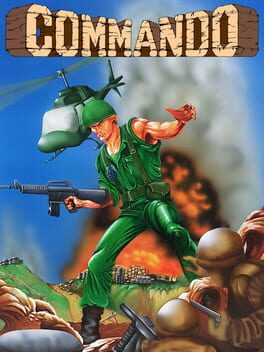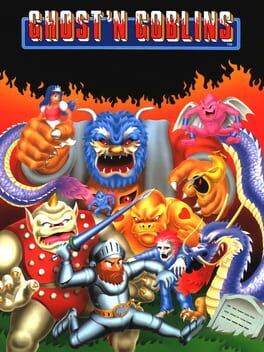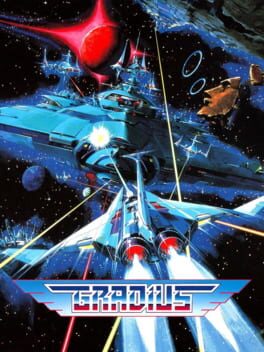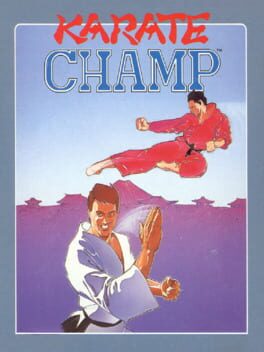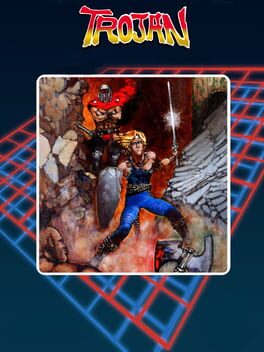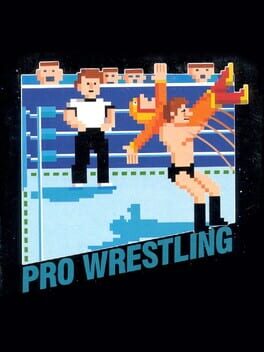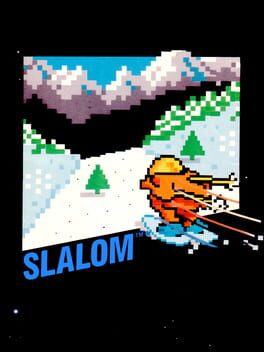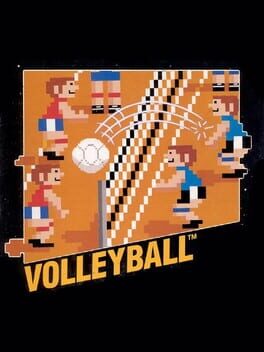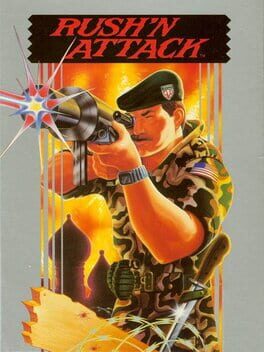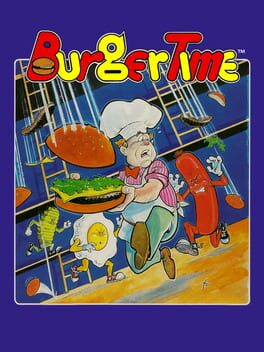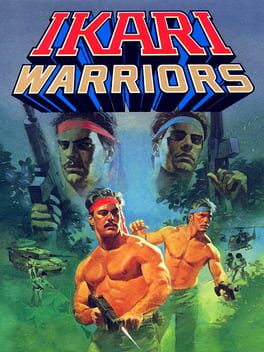Cadensia
BACKER
1984
Functional, the concept is not so much about being able to read patterns as it is about being able to string together bursts of warning shots. Enemy shots are always aimed at the controlled plane, so it's easy to dodge them by going in the opposite direction: the exercise is even easier in the advanced stages, where the quantity of planes and shots makes the console lag and gives more time to react. The flickering sprites in these phases are regrettable, sometimes masking a ship and causing an avoidable death. The diversity works relatively well for about ten stages before an unpleasant redundancy sets in, which the difficulty (more enemy fire) struggles to counterbalance.
1985
Shooter which is all about the multiplication of enemies and projectiles. Shots can only be fired in all eight directions, which sometimes causes problems. Grenades sometimes fail to hit their target, preventing to find ladders or power-ups. The repetition of the levels is certainly the most severe shadow for this title, as the difficulty only increases with the addition of projectiles per enemy.
1986
Extreme difficulty led by a heavy gameplay and deliberately broken movements (strange start-up frame before being able to move horizontally). The knockback on the loss of armour prevents it from being used as a sacrificial tool to effectively pass an opponent. The very tight dives of demons can be extremely frustrating, as can the amount of hit points of ghouls. Thus, inertia usually works against the player and a bad shot can be lethal, as only two projectiles can be displayed on the screen at the same time.
1986
A port of an arcade classic; some modifications exist to compensate for the technical limitations of the NES (two options maximum, change of visual design for the shield). The game is interesting because it forces you to think about your run with the purchase of power-ups. The counterpart is that it's difficult to come back from a death, in the last stages, when you lose your upgrades. Otherwise, the overall diversity is good and the title has the good taste of not being too long. Seemingly interesting aesthetic inclinations with the idea of a galactic empire, Bacterion, and its leader, a giant brain.
1984
Initial concept is poorly translated into the NES port. The idea is that each attack is mapped to a combination of a direction and a button (A, B or A+B). The problem is that the game doesn't have strict focal targeting, so much as the character only turns after a proper attack, when the positions are reversed. In practice, this means that it is not possible to learn actions in terms of forward-backward, but rather in terms of absolute direction. This deviation from the norm is a concern, as it is not necessarily possible to estimate the direction of our character's gaze. On the other hand, the automatic guard is particularly permissive. Overall, the title does not accept priority, which means that two attacks made at the same time will cancel each other out, regardless of the direction. The game then becomes a mid-range battle to force a certain favourable pattern (in my case, I estimated that baiting a jump with a low kick allows you to hit with a front kick or back kick, if parried). Indeed, since it is a karate game, there is no confirmation system, since each hit will stop the fight. In short, this is a title that did not transition well to the NES.
1986
Strangely enough, it didn't have the success of Ghosts 'n Goblins, even though the title is generally more enjoyable in its inertia and fighting style. It is therefore shorter and easier, requiring average reflexes. If the aesthetic choice doesn't offer a coherent background (a mix between ancient Greece, urban post-apo and desert), the diversity of the environments keeps the player's attention during the short hour of gameplay that it represents.
1986
Sort of a refinement of what Tag Team Wrestling and Kinnikuman were. The idea is to weaken the opponent with classic openers before starting the grappling series and do enough damage to get the tackle. It is unfortunate that the energy bars are not visible, although they can be inferred with the time it takes to get up. On the one hand, this forces you to set up a strategy to look for an overkill (since tackling too early gives the opponent the opportunity to regenerate life), but on the other hand, it cruelly lacks quality of life. It is clear that the winning loop emerges at the end: four standard grapplings, followed by six to eight special grapplings (the A high and A low), depending on the difficulty of the round. Note however that the spriting is sharper than for Kinnikuman, so the experience is somewhat better.
1987
Definitely a game I would have loved to like more: the initial concept is good and elegantly thought out with a good balance between time, freestyle and the idea of pushing towards aggressive gameplay with the solo points concept. Nevertheless, the game's overly high speed makes the experience particularly difficult and takes away much of the initial fun. As with Mach Rider, the very poor visibility prevents you from reacting properly to obstacles and the title becomes more of a rote game than a reflex game, which seemed to be its initial concept. A pity.
1986
Not a bad implementation of volleyball, since the randomness of the setting requires you to adjust your tactics according to the situation. The difficulty is not excessively high, so that a spike often wins over the opposing team. The length of the matches is regrettable, as the gameplay loop is too simple: volleyball strategy is enjoyable in real life, but hardly translates into a video game.
1985
A gameplay loop that is structured around three enemies: the black soldiers that you can attack on the ground, the red ones that you have to anti-air by jumping yourself and the orange ones that can shoot. The game is moderately difficult and has some good backgrounds that keep things varied. Nevertheless, it remains a rather poor title in the challenge it presents. It's a shame that the character grabs a ladder as soon as he's on it (without even having to press the up button), which is a problem when trying to kill the reds. Otherwise, if the bosses bring a bit of diversity, there is nothing particularly brilliant.
1983
There are eight different sports that are played in a similar way (for the athletic sports - shooting and archery test other skills), i.e. with the mashing of the A button and the addition of a direction for contextual actions. If the difficulty curve is rather well balanced, one can regret a certain lack of variety. It should also be noted that single button mashing forces you to use double-tap or vibration strategies. In the arcade, it is easy to practice double- or multi-tap, since the buttons are particularly large. This is much less true for an NES controller, although it is much easier than on recent controllers. This difficulty on a console certainly foreshadows alternate mashing, which requires the use of A and B.
1982
Particularly rigid gameplay with no snapshots on the platforms, which means that you have to be pixel-perfect on a ladder to be able to leave it. Beyond this impossibility to control your character properly, the concept of dropping platforms by stepping on them is rather simple and decent. One may regret the collision detection which, coupled with the different horizontal and vertical speeds, sometimes leads to complicated situations. Nevertheless, the presence of pepper spray trivializes the gameplay, making it just a very anecdotal and slightly frustrating game.
1986
Standard for the 2D action platformer. Inertia is handled well and the variety of weapons allows flexibility throughout the runs. The renewal of the gameplay loop is to be commended, with welcome little gimmicks and bosses that are always unique. The game suffers from some rather unpleasant difficulty spikes (the famous gear level with the eagles), but the difficulty remains overall well dosed, if only with the presence of holy water. The hybrid gameplay with the whip and a special weapon makes it possible to manage any type of situation and one is easily taken with the exploration, because bonuses save life, the roast fills the health bar and the multiplier makes weapons stronger.
1986
The rigidity of the gameplay makes it a particularly cruel title (even more so than Commando) that relies more on luck and rote learning than on any reflex. There is a lot of potential, especially with the vehicles, but this is counterbalanced by a heaviness that takes away every last ounce of fun. Stupidly difficult.
1986
Good balance between platforming and action game, with a certain richness in the mechanics. The inertia is good and makes the fights quite enjoyable. We can regret the cryptic nature of the bonuses and the fact that a death is largely punitive, since it ruins the farming efforts. The dungeons lack a little elegance, especially in the mapping, but are welcome additions to the game. The title thus mixes several different genres with some success: nothing is particularly brilliant, but the whole retains a charming coherence.

